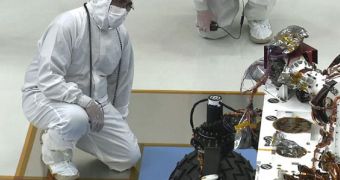Experts at the NASA Jet Propulsion Laboratory (JPL), in Pasadena, California, announce that the Curiosity rover finally managed to spin its wheels for the first time. The robot, currently under construction, is destined to be the American space agency's next mission to the Red Planet, and is scheduled for launch next year. With the successful completion of the first drive tests, the Mars Science Laboratory exploration rover, now called Curiosity, showed that its construction is on track.
“This is great, this is really exciting. This is a huge milestone […] It's a rover,” says MSL mission deputy project scientist Ashwin Vasavadaor, quoted by Space. The expert says that the machine, which is still not covered, and allows for all of its components to be seen, drove about 3 feet, or 1 meter, back and forth during the tests. The goal of this phase was to determine whether the electronic systems, computer software, and hardware devices involved in moving were running at optimal levels. The drives took place yesterday, July 24.
Work on Curiosity is currently progressing at an accelerated step, JPL experts say. Through this week, the team managing the construction efforts mounted two Navcams (navigation cameras), two Mastcams (cameras that go on Curiosity's mast), and the ChemCam. The latter instrument conducts chemical analysis of various samples, and also features a laser device, which it controls directly. The Remote Sensing Mast – MSL's head and neck – was also installed this week. The machine moves around on six aluminum wheels, which support almost a ton of weight.
After the most recent additions, Curiosity is currently about 2 meters (7 feet) tall. Its science instruments are capable of drilling through about 5 centimeters (2 inches) of rock, which should be sufficient to allow investigators to reach the geological layers they are most interested in. Still to be added on the machine is the 6-foot (1.8-meter) robotic arm, which will feature both analysis instruments and video cameras. “We've been following the water for a decade of so, and now we know there is water on Mars. What MSL will do is take a next-generation set of instruments, and in detail, determine the habitability,” Vasavadaor concludes.

 14 DAY TRIAL //
14 DAY TRIAL //